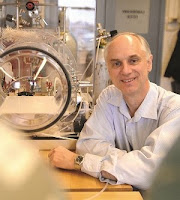Synthetic Trees Remove CO2 from Atmosphere !
There are people who think outside the box. Then there are people like Klaus Lackner who throw the box away entirely when they think. While others argue over new ways to reduce greenhouse gas emissions, Lackner has methods that will, as he puts it, “close the carbon loop” altogether.
“Stabilizing the concentration of carbon dioxide in the air requires reducing carbon dioxide emissions to nearly zero,” Lackner said in testimony before the House Science and Technology Subcommittee on Energy and Environment recently. “Think of pouring water into a cup: as long as you pour water into the cup, the water level in the cup goes up. It does not matter whether the maximum level is one inch below the rim or one and a half inches below the rim. In either case, you will eventually have to stop pouring.”
That sort of big-picture thinking is nothing new for the Ewing and J. Lamar Worzel Professor of Geophysics in the Department of Earth and Environmental Engineering. His efforts to find systemscale solutions to humanity’s demand for energy set the stage for Lackner’s seminal conclusion in 1999 that, to truly control carbon emissions, we would have to learn how to remove carbon dioxide directly from the air. The wind, he calculated, is vastly more efficient at transporting carbon dioxide to a collection device than it is as a means of generating electricity.
Now Lackner has taken his ideas one step further and is working with Global Research Technologies to create artificial trees that will pull carbon dioxide from the air, just as real trees do. His air capture machines are like giant filters that trap the carbon dioxide that will be later freed and converted into a liquid: syngas, synthetic gas that can be used as a fuelstock. Alternatively, it could be disposed of through geologic and mineral sequestration.
Our reliance on liquid hydrocarbon fuels for transportation has led Lackner to search for affordable low-carbon production methods. In a nod to his work contemplating an auxon army, he and his colleagues at the Lenfest Center for Sustainable Energy are looking for ways to apply the benefits of mass production to energy and fuels to drive down costs. In addition, he is taking a serious look at solar power as a way to eliminate carbon emissions from fuel production entirely and bring us closer to achieving a carbon-neutral society rather than simply dealing with the effects of climate change as they occur by doing such things as blocking a portion of the sun’s radiation.
“Imagine if we decided to solve our garbage problem by putting houses on stilts and raising them a little every year,” said Lackner. “That’s what a lot of geoengineering amounts to, and that’s not a solution to the problem. A real solution will only come by completely rethinking the way we use carbon.”
Learn more at [Link]
Watch the [VIDEO]


Comments
Post a Comment